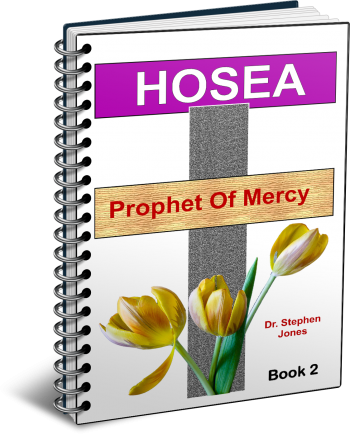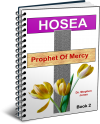Latest Posts
View the latest posts in an easy-to-read list format, with filtering options.

Hosea's failed marriage was a prophetic type of God's failed marriage with Israel. Hosea's harlot wife, Gomer, was named to represent Israel, because Gomer was the official name which the Assyrians called Israel. Her divorce and subsequent redemption shows the mercy of God.
Category - Bible Commentaries

After speaking of Israel’s resurrection, Hosea 6:3 says,
3 So let us know, let us press on to know the Lord. His going forth is as certain as the dawn; And He will come to us like the rain, like the spring rain watering the earth.
This is a messianic prophecy in terms of the coming of the Lord (i.e., Yahweh). This is one of many places where Christ is called Yahweh, and the coming of Christ is the coming of Yahweh to the earth. In other words, Yahweh was incarnated at Bethlehem and became known in His earthly appearance as Yeshua, or Jesus.
Christ’s appearance on the earth, the prophets tells us, “is as certain as the dawn.” Not only is it a certainty, but it is also like the dawn, because He is the light of the world (John 9:5). He is pictured as the rising sun in Mal. 4:2, saying, “the sun of righteousness will rise with healing in its wings.” The early morning rays of sun are called “wings” here. These “wings” are said to heal those who walk in darkness (or blindness).
The coming of Christ is compared to two kinds of rain, which the NASB translators fail to make clear in their translation of Hosea 6:3. The KJV is more accurate, reading, “He shall come unto us as the rain, as the latter and former rain unto the earth.” The former rain watered the earth in November after the feast of Tabernacles when wheat and barley were planted.
The latter rain came in April between Passover and Pentecost while the barley was harvested. A sheaf of barley was waved on the first Sunday after Passover. The wheat, which ripened about six or seven weeks after barley, needed the latter rain to ripen, so that it could be used as the Pentecostal offering (Lev. 23:16, 17).
These rains foreshadowed the outpouring of the Holy Spirit in the feasts of Tabernacles and Pentecost, planting and harvest. Even so, the “latter rain” was fulfilled first when the Holy Spirit was poured out on the day of Pentecost. We now look for the “former rain” in the fulfillment of the feast of Tabernacles.
The rain of Pentecost signified the time of harvest at the end of the previous growing season, after Jesus gave the Great Commission in Matt. 28:18-20. But the rain of Tabernacles at the end of the age prophesies of another outpouring of the Holy Spirit that prepares the earth for the planting of a new crop. This new growing season is the time when the Kingdom grows until it fills the whole earth, ending with the harvest of all the dead, great and small (Rev. 20:12).
Hosea 6:3 (KJV) gives the order of these rains as “the latter and former rain,” suggesting that the latter rain was to come first. That is, of course, exactly what happened, since the rain of Pentecost was fulfilled in Acts 2, while the feast of Tabernacles has yet to be fulfilled.
The word “latter” is the Hebrew word malqowsh, which comes from laqash, the “after-crop, late fruit.” Perhaps this was a reference to the wheat harvest, which came after the barley was harvested. In that sense, wheat was late—hence, it was the latter crop that needed the latter rain to ripen.
As for the “former rain,” the Hebrew word used in Hosea 6:3 is yoreh, “sprinkling,” from yara, “to flow” (as water). It also means “to cast,” where Pharaoh’s army was “cast” into the sea (Exodus 15:4), and to “shoot” arrows (Num. 21:30 KJV; Psalm 11:2; 64:7). Hence, it refers not only to flowing water from rain, but also to arrows being shot by an archer. In 1 Sam. 31:3, we read about the death of King Saul,
3 The battle went heavily against Saul, and the archers [yoreh] hit him; and he was badly wounded by the archers [yoreh].3 The battle went heavily against Saul, and the archers[yoreh] hit him; and he was badly wounded by the archers[yoreh].
In Hebrew thought, the “former rain” had a double meaning. First it referred to rain itself, but secondarily it referred to an archer shooting arrows. It was also a metaphor for a teacher hitting the mark with words of truth. Furthermore, arrows metaphorically represented sons (Psalm 127:3-5), and lightning was said to be God’s arrows (Psalm 18:14). Hence, lightning was a metaphor for the sons of God being shot from His bow as arrows into the earth.
Therefore, Hosea’s prophecy about the former rain, associated with the feast of Tabernacles, is really about the manifestation of the sons of God, who are sent as rain to a parched world as teachers of refreshing truth, hitting the “bull’s eye.”
Joel is a more well-known prophet who speaks of the outpouring of the Holy Spirit. He is quoted in Peter’s Pentecostal sermon in Acts 2:16-21. We read in Joel 2:23,
23 So rejoice, O sons of Zion, and be glad in the Lord your God; for He has given you the early rain [moreh tsedakah, “teacher of righteousness”] for your vindication. And He has poured down for you the rain, the early [moreh, “archer, teacher”] and latter rain [malqowsh] as before.
This prophet speaks of both the malqowsh (late fruit, i.e., the wheat harvest, which comes after the latter rain) and the moreh (the early rain, arrows from archers, or teachers, which is associated with the feast of Tabernacles). He adds the detail of the moreh tzedakah, which can be translated either as “early rain” or as “teacher of righteousness.” Obviously, it means both, because the rain was a physical sign prophesying of the outpouring of the Holy Spirit.
The Spirit was also to be sent by the Messiah, our great Teacher of Righteousness, and the secondary effect was that God would send forth His sons as lightning to bring truth to the world.
The Sadducees were named for Zadok, or Tsedek, and believed that the priest who founded that sect had been prophesied in Joel 2:23. As Christians, we do not agree with them, for we see Jesus as the great Teacher of Righteousness. Nonetheless, their belief shows how Joel 2:23 may be translated and how it prophesied of One who was yet to come.
Joel’s prophecy supports Hosea 6:3 in setting forth the two works of Christ as two rains of the Holy Spirit upon the earth at differing time periods. The latter rain came at Pentecost in Acts 2, but the former (or early) rain is yet to come at the feast of Tabernacles. In both cases, the Messiah is the Originator of these “rains,” but the effect of the rain—especially the early rain—is to bring truth to the earth through the sons of God.
The book of Acts is a history of the early church in the aftermath of the latter rain, but it is also a prophecy of the sons of God at the time of the former rain. Acts 2 speaks of the latter rain of Pentecost, but from Acts 3-12 we see clear prophecy of the early rain of Tabernacles. That study would make us stray too far from our text at hand, but we may point out that in Acts 4:31 we read of a second outpouring of the Holy Spirit.
31 And when they had prayed, the place where they had gathered together was shaken, and they were all filled with the Holy Spirit and began to speak the word of God with boldness.nd when they had prayed, the place where they had gathered together was shaken, and they were all filled with the Holy Spirit and began to speak the word of God with boldness.
It is significant that this outpouring resulted in the believers speaking the word of God with boldness. This prophesied of a future time, when the sons of God would be sent into the earth as God’s arrows of truth. The fulfillment of the feast of Tabernacles will begin a new day of understanding the word of God in a way not known earlier.
The day of Pentecost was marked by the disciples speaking with other tongues (Acts 2:4), but the second time they spoke “the word of God.” Both times the word was spoken, of course, but the subtle difference in terminology suggests greater understanding in the ears of the hearers. This word of truth will lay a foundation of truth for the Kingdom of God, and it will grow until it fills the whole earth.
The church under its Pentecostal anointing (since Acts 2) has been limited in its understanding of truth, because Pentecost was a leavened feast (Lev. 23:17). There have been many “revivals” throughout church history, where the Holy Spirit moved in special ways in various parts of the earth. Each revival has been accompanied by a particular truth that the Spirit was injecting into the church, and in each case that truth was accepted by a few and rejected by the majority.
As I contemplate the last great revival, the final outpouring of the Holy Spirit that so many even now anticipate, my question has been this: What great truth will the Holy Spirit inject into the church in this final revival? What truth is necessary to bring about the Kingdom Age, which will last a thousand years? What will the sons of God preach with boldness?
In my view, it is the revelation of the law of God, which is necessary to establish the Kingdom. It must be understood as a spiritual law (Rom. 7:14) and applied according to New Covenant methods, but it is still the law of God. That, to me, is the revelation that has yet to be injected into the church throughout the leavened Age of Pentecost.